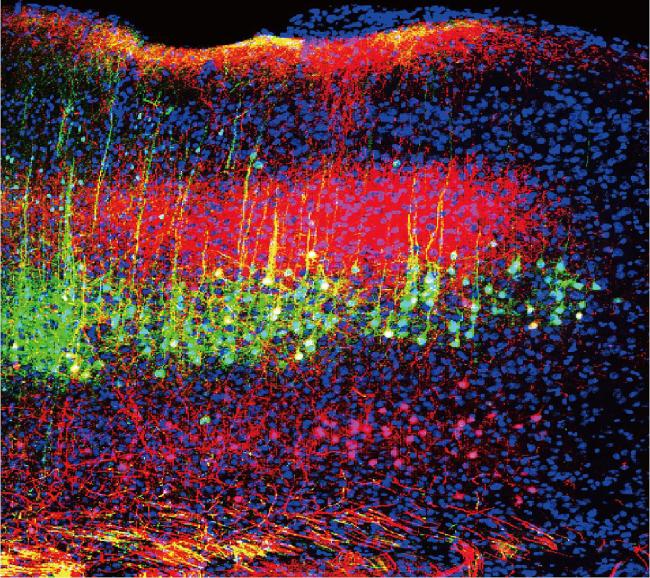Understanding how sound suppresses pain
July 26, 2022
Understanding how sound suppresses pain
At a Glance
- Scientists used mice to identify brain circuits through which sound can blunt pain.
- The findings could potentially lead to the development of safer methods for treating pain.

Studies dating back decades have shown that music and other kinds of sound can help alleviate acute and chronic pain in people. This is true for pain from dental and medical surgery, labor and delivery, and cancer. However, how the brain produces this pain reduction, called analgesia, was less clear.
An international team of scientists set out to use mice to explore the neural mechanisms through which sound blunts pain. The team was led by researchers at NIH’s National Institute of Dental and Craniofacial Research (NIDCR); the University of Science and Technology of China, Hefei; and Anhui Medical University in Hefei, China. Their study was published in Science on July 8, 2022.
The scientists first exposed mice with inflamed paws to three types of sound: a pleasant piece of classical music, an unpleasant rearrangement of the same piece, and white noise. Surprisingly, all three reduced pain sensitivity in the mice when played just slightly louder than background noise (about the level of a whisper). The effect lasted well beyond the sound itself—for at least two days after exposure to the sound three days in a row for 20 minutes. When played louder, the sounds had no effect on the animals’ pain responses.
Pain perception can be affected by emotions and stress. However, the scientists discovered that low-intensity sound didn’t affect the mice in tests of stress and anxiety. The finding shows that this particular type of sound affected the animal’s perception of pain through another mechanism.
To explore the brain circuitry underlying this effect, the team used techniques to trace connections between brain regions. They identified a route from the auditory cortex, which receives and processes information about sound, to the thalamus, which acts as a relay station for sensory signals, including pain, from the body. In freely moving mice, low-intensity white noise reduced the activity of neurons in the thalamus at the receiving end of this pathway.
Suppressing the pathway in the absence of sound, the team found, mimicked the pain-blunting effects of low-intensity noise. In contrast, activating the pathway restored the animals’ sensitivity to pain in the presence of sound. The scientists also identified distinct brain circuits through which sound blunted pain from hindpaws and forepaws.
“Human brain imaging studies have implicated certain areas of the brain in music-induced analgesia, but these are only associations,” explains co-senior author Dr. Yuanyuan Liu of NIDCR. “In animals, we can more fully explore and manipulate the circuitry to identify the neural substrates involved.”
Liu notes that it is unclear if similar brain processes are involved in humans. Other aspects of sound, such as its perceived harmony or pleasantness, may be important for human pain relief. “We don’t know if human music means anything to rodents, but it has many different meanings to humans—you have a lot of emotional components,” he adds.
“We need more effective methods of managing acute and chronic pain, and that starts with gaining a better understanding of the basic neural processes that regulate pain,” says NIDCR Director Dr. Rena D’Souza. “By uncovering the circuitry that mediates the pain-reducing effects of sound in mice, this study adds critical knowledge that could ultimately inform new approaches for pain therapy.”
Related Links
- Retraining the Brain to Treat Chronic Pain
- Gene Therapy for Chronic Pain Relief
- Study Finds Link Between Red Hair and Pain Threshold
- Pain Rising Among Younger Americans with Less Education
- Scientists Find New Pain-Suppression Center in the Brain
- Yoga Eases Moderate to Severe Chronic Low Back Pain
- Managing Pain: Moving Beyond Opioids
- Pain: You Can Get Help
References
Sound induces analgesia through corticothalamic circuits. Zhou W, Ye C, Wang H, Mao Y, Zhang W, Liu A, Yang CL, Li T, Hayashi L, Zhao W, Chen L, Liu Y, Tao W, Zhang Z. Science. 2022 Jul 8;377(6602):198-204. doi: 10.1126/science.abn4663. Epub 2022 Jul 7. PMID: 35857536.
Funding
NIH’s National Institute of Dental and Craniofacial Research (NIDCR); National Key Research and Development Program of China Brain Science and Brain-Like Intelligence Technology; National Natural Science Foundation of China; Science Fund for Creative Research Groups of the National Natural Science Foundation of China; CAS Project for Young Scientists in Basic Research; Natural Science Foundation of Anhui Province; the University of Science and Technology of China Research Funds of the Double First-Class Initiative.


